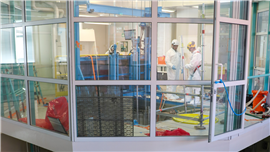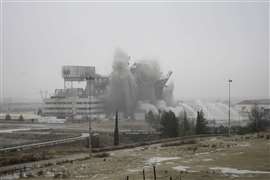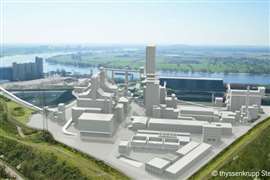Fortum completes Finland’s first nuclear decommissioning
16 July 2024
Fortum, a Nordic energy company, has carried out what is believed to be Finland’s first nuclear decommissioning project together with VTT Technical Research Centre of Finland, the owner of the reactor.
 In the research space located above the reactor, preparations were made to transfer the radioactive heart component to the lower level of the building through the open door visible on the right side of the picture. (PHOTO: VTT)
In the research space located above the reactor, preparations were made to transfer the radioactive heart component to the lower level of the building through the open door visible on the right side of the picture. (PHOTO: VTT)
The company recent dismantled the FiR1 research reactor, which was located at VTT’s premises at the Aalto University’s Otaniemi campus in Espoo.
In operation for over fifty years, the 250-kilowatt reactor was commissioned in 1962 and shut down in 2015. Over the decades it was used for a wide range of research purposes, including those designed to serve healthcare sector.
The scope of Fortum’s decommissioning work comprised planning, preparatory measures, dismantling works and waste management, including the final disposal of decommissioning waste classified as radioactive.
According to VTT, “The total decommissioning costs amounted to approximately €24 million (€22 million), pre-funded by the Finnish Nuclear Waste Management Fund.
“About 40 individuals [from both Fortum and VTT] worked on the decommissioning site at various stages and in shifts. Some VTT employees had worked with the reactor for decades.
“Three to four workers primarily carried out the actual dismantling, with others managing waste disposal, radiation monitoring, and site supervision.”
Fortum, which acted as the project’s main contractor, began dismantling the structure in June 2023.
While this part of the project work was concluded in April of this year, Fortum’s work on the project will continue with the final disposal of demolition waste in the Loviisa power plant’s final repository for low and intermediate-level waste.
Fortum said: “As the reactor was designed for research and educational use, the amount of decommissioning waste and the associated radioactivity were relatively small.
“The total amount of demolition waste to be disposed of in Fortum’s Loviisa nuclear power plant’s low and intermediate level waste repository was approximately 60 cubic metres, most of which was concrete.”
Markus Airila, VTT’s principal scientist, who led the project and served as the decommissioning manager, said: “The dismantling phase was very swift, thanks to thorough planning and preparatory work.
“Additionally, it was crucial that we could leverage the strong nuclear safety culture and expertise from Fortum’s Loviisa nuclear power plant.
“Fortum handled everything safely, efficiently, and on schedule without significant delays.”
With safety the priority throughout the planning and execution of the plant’s decommissioning, the works were carried out under the oversight of the Radiation and Nuclear Safety Authority of Finland (STUK).
Additionally, the dismantling of the FiR1 reactor - while much smaller in size than commercial reactors - aims to serve as a domestic model for decommissioning commercial nuclear units and to “create new expertise for the benefit of VTT’s and Fortum’s international customers”.
Antti Ketolainen, Fortum’s director in charge of the project, said: “For us at Fortum, this successful project is a testament to our extensive expertise, covering the entire lifecycle of a nuclear facility.
“We have executed a nuclear facility decommissioning project with the same quality and competence with which we have operated nuclear facilities and delivered projects for external customers over decades.”
Antti added: “We gained a lot of lessons and experience from the FiR1 project, which we can use to develop our operations and support our service business customers, for example, in preparing decommissioning plans and cost estimates.”








